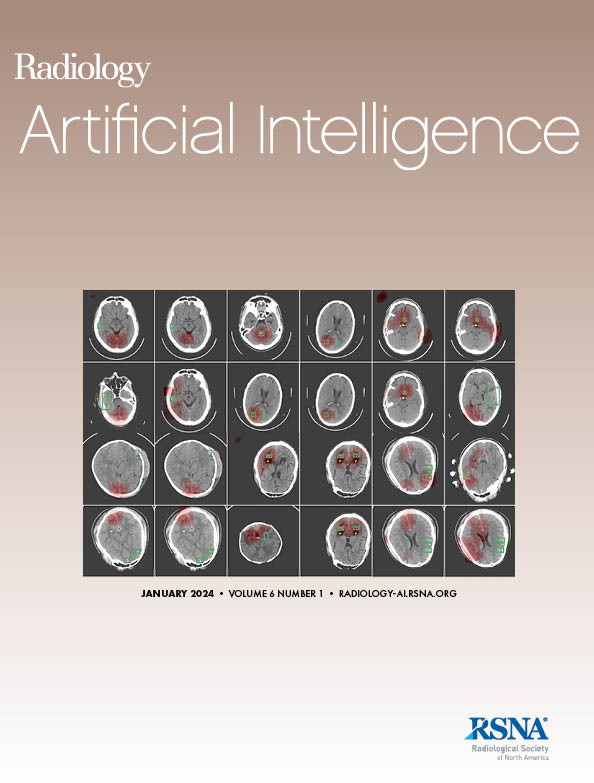Shao-Hong Wu, Ming-De Li, Wen-Juan Tong, Yi-Hao Liu, Rui Cui, Jin-Bo Hu, Mei-Qing Cheng, Wei-Ping Ke, Xin-Xin Lin, Jia-Yi Lv, Long-Zhong Liu, Jie Ren, Guang-Jian Liu, Hong Yang, Wei Wang
求助PDF
{"title":"自适应双任务深度学习用于筛查美国甲状腺癌的自动分类。","authors":"Shao-Hong Wu, Ming-De Li, Wen-Juan Tong, Yi-Hao Liu, Rui Cui, Jin-Bo Hu, Mei-Qing Cheng, Wei-Ping Ke, Xin-Xin Lin, Jia-Yi Lv, Long-Zhong Liu, Jie Ren, Guang-Jian Liu, Hong Yang, Wei Wang","doi":"10.1148/ryai.240271","DOIUrl":null,"url":null,"abstract":"<p><p>Purpose To develop an adaptive dual-task deep learning model (ThyNet-S) for detection and classification of thyroid lesions at US screening. Materials and Methods This retrospective study used a multicenter dataset comprising 35 008 thyroid US images of 23 294 individual examinations (mean age, 40.4 years ± 13.1 [SD]; 17 587 female) from seven medical centers from January 2009 to December 2021. Of these, 29 004 images were used for model development and 6004 images for validation. The model determined cancer risk for each image and automatically triaged images with normal thyroid and benign nodules by dynamically integrating lesion detection through pixel-level feature analysis and lesion classification through deep semantic features analysis. Diagnostic performance of screening assisted by the model (ThyNet-S triaged screening) and traditional screening (radiologists alone) was assessed by comparing sensitivity, specificity, accuracy, and area under the receiver operating characteristic curve using the McNemar test and DeLong test. The influence of ThyNet-S on radiologist workload and clinical decision-making was also assessed. Results ThyNet-S-assisted triaged screening achieved a higher area under the receiver operating characteristic curve than original screening with six senior and six junior radiologists (0.93 vs 0.91 and 0.92 vs 0.88, respectively; all <i>P</i> < .001). The model improved sensitivity for junior radiologists (88.2% vs 86.8%; <i>P</i> < .001). Notably, the model reduced radiologists' workload by triaging 60.4% of cases as not potentially malignant, which did not require further interpretation. The model simultaneously decreased the unnecessary fine needle aspiration rate from 38.7% to 14.9% and 11.5% when used independently or in combination with the Thyroid Imaging Reporting and Data System, respectively. Conclusion ThyNet-S improved the efficiency of thyroid cancer screening and optimized clinical decision-making. <b>Keywords:</b> Artificial Intelligence, Adaptive, Dual Task, Thyroid Cancer, Screening, Ultrasound <i>Supplemental material is available for this article.</i> © RSNA, 2025.</p>","PeriodicalId":29787,"journal":{"name":"Radiology-Artificial Intelligence","volume":" ","pages":"e240271"},"PeriodicalIF":13.2000,"publicationDate":"2025-05-01","publicationTypes":"Journal Article","fieldsOfStudy":null,"isOpenAccess":false,"openAccessPdf":"","citationCount":"0","resultStr":"{\"title\":\"Adaptive Dual-Task Deep Learning for Automated Thyroid Cancer Triaging at Screening US.\",\"authors\":\"Shao-Hong Wu, Ming-De Li, Wen-Juan Tong, Yi-Hao Liu, Rui Cui, Jin-Bo Hu, Mei-Qing Cheng, Wei-Ping Ke, Xin-Xin Lin, Jia-Yi Lv, Long-Zhong Liu, Jie Ren, Guang-Jian Liu, Hong Yang, Wei Wang\",\"doi\":\"10.1148/ryai.240271\",\"DOIUrl\":null,\"url\":null,\"abstract\":\"<p><p>Purpose To develop an adaptive dual-task deep learning model (ThyNet-S) for detection and classification of thyroid lesions at US screening. Materials and Methods This retrospective study used a multicenter dataset comprising 35 008 thyroid US images of 23 294 individual examinations (mean age, 40.4 years ± 13.1 [SD]; 17 587 female) from seven medical centers from January 2009 to December 2021. Of these, 29 004 images were used for model development and 6004 images for validation. The model determined cancer risk for each image and automatically triaged images with normal thyroid and benign nodules by dynamically integrating lesion detection through pixel-level feature analysis and lesion classification through deep semantic features analysis. Diagnostic performance of screening assisted by the model (ThyNet-S triaged screening) and traditional screening (radiologists alone) was assessed by comparing sensitivity, specificity, accuracy, and area under the receiver operating characteristic curve using the McNemar test and DeLong test. The influence of ThyNet-S on radiologist workload and clinical decision-making was also assessed. Results ThyNet-S-assisted triaged screening achieved a higher area under the receiver operating characteristic curve than original screening with six senior and six junior radiologists (0.93 vs 0.91 and 0.92 vs 0.88, respectively; all <i>P</i> < .001). The model improved sensitivity for junior radiologists (88.2% vs 86.8%; <i>P</i> < .001). Notably, the model reduced radiologists' workload by triaging 60.4% of cases as not potentially malignant, which did not require further interpretation. The model simultaneously decreased the unnecessary fine needle aspiration rate from 38.7% to 14.9% and 11.5% when used independently or in combination with the Thyroid Imaging Reporting and Data System, respectively. Conclusion ThyNet-S improved the efficiency of thyroid cancer screening and optimized clinical decision-making. <b>Keywords:</b> Artificial Intelligence, Adaptive, Dual Task, Thyroid Cancer, Screening, Ultrasound <i>Supplemental material is available for this article.</i> © RSNA, 2025.</p>\",\"PeriodicalId\":29787,\"journal\":{\"name\":\"Radiology-Artificial Intelligence\",\"volume\":\" \",\"pages\":\"e240271\"},\"PeriodicalIF\":13.2000,\"publicationDate\":\"2025-05-01\",\"publicationTypes\":\"Journal Article\",\"fieldsOfStudy\":null,\"isOpenAccess\":false,\"openAccessPdf\":\"\",\"citationCount\":\"0\",\"resultStr\":null,\"platform\":\"Semanticscholar\",\"paperid\":null,\"PeriodicalName\":\"Radiology-Artificial Intelligence\",\"FirstCategoryId\":\"1085\",\"ListUrlMain\":\"https://doi.org/10.1148/ryai.240271\",\"RegionNum\":0,\"RegionCategory\":null,\"ArticlePicture\":[],\"TitleCN\":null,\"AbstractTextCN\":null,\"PMCID\":null,\"EPubDate\":\"\",\"PubModel\":\"\",\"JCR\":\"Q1\",\"JCRName\":\"COMPUTER SCIENCE, ARTIFICIAL INTELLIGENCE\",\"Score\":null,\"Total\":0}","platform":"Semanticscholar","paperid":null,"PeriodicalName":"Radiology-Artificial Intelligence","FirstCategoryId":"1085","ListUrlMain":"https://doi.org/10.1148/ryai.240271","RegionNum":0,"RegionCategory":null,"ArticlePicture":[],"TitleCN":null,"AbstractTextCN":null,"PMCID":null,"EPubDate":"","PubModel":"","JCR":"Q1","JCRName":"COMPUTER SCIENCE, ARTIFICIAL INTELLIGENCE","Score":null,"Total":0}
引用次数: 0
引用
批量引用

 求助内容:
求助内容: 应助结果提醒方式:
应助结果提醒方式:


